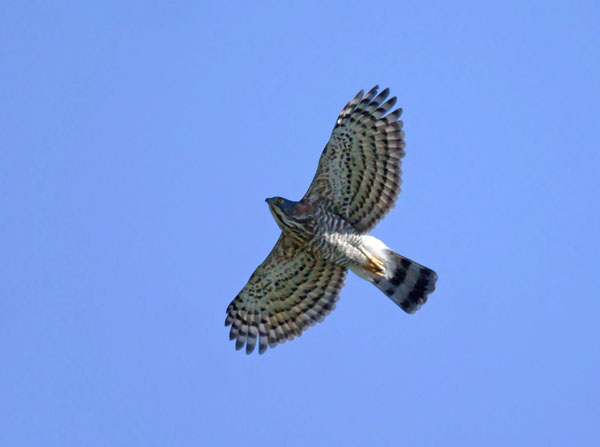Accipiter trivirgatus
IUCN
LCBasic Information
Scientific classification
- name:Accipiter trivirgatus
- Scientific Name:Crested Goshawk
- Outline:Raptor
- Family:Accipitriformes Accipitridae Accipiter
Vital signs
- length:41-49cm
- Weight:360-530g
- lifetime:10year
Feature
It likes to soar in the sky for a long time, and its wings often press down and shake when flying, which can be regarded as its iconic flying feature.
Distribution and Habitat
In China, it is traditionally distributed in Southwest China, South China, Hainan Island and Taiwan Island. This species has been recorded many times in Beijing's raptor migration monitoring, showing a standard migration state. Other evidence also shows that the population has a tendency to expand to East China and further north in recent years, which is worth noting. Abroad, it is distributed in the Indian subcontinent, Sri Lanka, Indochina, Indonesia and the Philippines.
It inhabits mountain forests and forest margins at medium and low altitudes, and sometimes flies over plains and villages. It also appears in bamboo forests and can be seen in many urban parks in the south. It is not very afraid of people and does not like to pay attention to other raptors.
Appearance
A medium-sized bird of prey. It is medium-sized but strong, and the female is significantly larger than the male.
Six wing fingers can be seen when this species is flying. The plumage of males and females is similar. The back of an adult bird is dark brown or gray-brown, the abdomen is white, the head to the back of the neck is mouse-gray, with brown short crest feathers, and the throat is white, but there is a thick midline of the throat. The chest has vertical stripes and the abdomen has horizontal stripes. The undertail coverts are white and well-developed. When flying, you can see that they are "fluffy" protruding from the sides of the body, which is more obvious in adult males. The back of an immature bird is lighter brown, the abdomen is beige, the body has vertical stripes or densely arranged vertical spots, and the undertail coverts are not as obvious as those of an adult. It is similar to a sparrowhawk, but the body is obviously sturdy. When it lands, it can b
Details
The Crested Owl is a medium-sized bird of prey. It is a resident bird. It is good at hiding and alert. It often hides in the leaves, and sometimes perches on isolated branches in the open. It is a sunrise bird. It mostly acts alone, flies slowly and not very high. Sometimes it uses the rising thermal air currents to hover and soar in the air. When hovering, its wings are often pressed down and shaken. It is very territorial. It feeds on animal food such as frogs, lizards, rodents, insects, and also eats birds and small mammals. It mainly hunts on the ground in the forest, often hiding among the branches, and suddenly attacks when it finds prey. The call is relatively quiet, a sharp call of he-he-he-he-he-he and a long bark.

There are 11 subspecies of the Crested Owl in the world, 2 of which are in China. They are not rare in the region and are found in lowland forests in south-central and southwestern China, including Hainan Island and Taiwan Island. They are common in Hong Kong. The Taiwan subspecies is a Chinese endemic subspecies, only distributed in Taiwan, and is not common; the common subspecies distributed in other areas is a resident bird and is relatively rare. New records have been reported in Yongtai, Fujian and Shiyan, Hubei.

The breeding season is from April to July. During the breeding season, they often soar over the forest, making loud calls and nesting in tall trees in coniferous or broad-leaved forests, 6-30 meters above the ground. The nest is relatively rough, mainly made of dead branches, with some green leaves inside. The nesting location is mostly near the river bank or pond, not far from the water. If the breeding is successful, the nest will continue to be used next year. During the incubation period, they are extremely territorial and sometimes even attack people who enter the vicinity of the nest.
The number of subspecies distributed in China is relatively common, and it is not rare in the region, but the population is not high. It is listed as a rare species in the bird volume of the "Red Data of Endangered Animals in China"; it is listed in the list of key protected wild animals in China. It is listed in the list of second-level protected wild animals in China.








